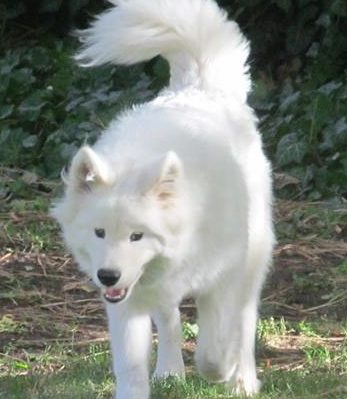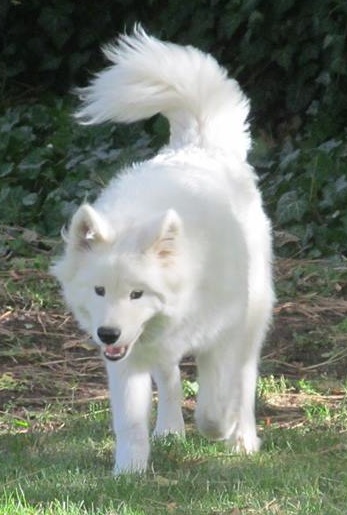
Humans aren’t the only species suffering from an epidemic of obesity. Our family pets aren’t looking too svelte, either. I’m not a sociologist, I’m a dog trainer, so I’m not here to discuss why humans are overweight. (Not my job!) With pets, though, it’s a lot easier to analyze.
Pets are overweight because of what we feed them. It might not be that we are feeding too much; perhaps we are feeding the wrong foods. Most likely though, we are also feeding too much. That’s got to stop.
Know Your Pet’s Weight
- Cats and smaller dogs can be weighed at home if you’re willing to weigh yourself without them, then stand on the scale with them. (It’s a great arithmetic problem for your kids to help solve!)
- Larger dogs can be weighed at your veterinarian’s office. It’s a wonderful opportunity for a “happy visit” to the clinic when there’s nothing wrong with the pet.
√ Go during the quietest time, often when most of the staff is at lunch.
√ Ask if it’s okay (they like these visits!).
√ Ask to have the weight noted on the pet’s chart.
- Use treats and a calm, encouraging demeanor to show your pet that weighing can be non-stressful. Keep smaller or shyer pets in their carrying kennels if it seems better for them that way.
Weigh Your Pet Often
- Make weighing a regular occurrence. Keep a written record.
- Weigh once a month if your pet is a puppy, is on a diet, has been ill, or is achieving senior status. Weight loss or gain can be an early indicator of more serious issues.
- Don’t beat yourself up if the diet isn’t going as well as you’d hoped—and certainly don’t project your disappointment on your pet!

Measure What You Feed
- Use a measuring cup, not just a scoop or empty plastic container. You need to know how many cups your pet is eating every day, because that’s how food is measured.
- When you discuss what you’re feeding with your veterinarian or a pet supply store staffer, remember to indicate whether you’re feeding kibble, canned food, or a combination.
- When you know the exact amount of food you’re giving each pet each day, you’ll easily be able to adjust the amount up or down according to need. Has your pet’s weight gone up, higher than your veterinarian advises? Say you’ve been feeding three cups a day—cut back to two-and-a-half cups and see how that goes. Reassess in a few weeks with another weighing and take it from there.
Dogs Don’t Have to Eat Out of a Bowl
That might be true for some cats, too, but usually cats prefer eating the same thing in the same place every day, and they often don’t take too well to changes.
Dogs, on the other hand, can be more adventurous about eating. Many dogs will eat anywhere, anytime, as long as they like the food. When you have a dog who’s very enthusiastic about food—to the point of liking it so much that he’s been deemed at risk for obesity by your veterinarian—you dread cutting him back on quantity. He likes his food so much, it almost seems mean!
Trust me, it isn’t. It’s for his own good.
- Slow down your dog’s eating by feeding him from a food toy or a food puzzle. Give him a chance to spend more time consuming each meal by freezing his food in a KONG or by filling any of the other wonderful food-containing toys on the market today, so the dog has to move the toy around to get the food to drop out of it.
- Make your own inexpensive food puzzle with a muffin tin and some tennis balls. Hide kibble in the muffin cups, then cover each with a tennis ball.
- Keep in mind that interacting with a food toy or puzzle can be a fairly high-energy occupation for many dogs, so find a safe place to feed your adventurous Fido so he doesn’t disrupt your house while he’s serving himself dinner.
Bulk Up What You Feed
- If you soak his kibble in water for a few hours before feeding, your dog will perceive that he’s getting a larger quantity of food. Most kibble bulks up some, and many kibbles bulk up a lot. My dogs get about three cups of soaked food from one cup of dry kibble.
- For larger-breed dogs, veterinarians often recommend serving a gruel of soaked kibble for dogs who might bloat or experience torsion. I feed all my dogs, even the five-pounder, soaked kibble; I even warm it up a bit in colder months.
- Put in vegetables that add bulk but not calories or sugar. My dogs’ favorites are green beans and pumpkin (also good for fiber). Check online for a full list of safe vegetables to feed. These will show up again in their eliminations, so don’t be surprised if you see orange when you scoop!
Don’t Forget to Count the Treats
- Feed healthy treats only.
- Consider making some of your own. Use the smallest possible pieces, even for larger dogs. Dogs are more impressed with flavor and presentation than they are with size. For example, you can cut a turkey hot dog into 10 pieces or into 50 pieces—50 is far more economical and much, much better for your dog. He’ll get 50 treats instead of 10!
- Measure the treats by amount and by content. In other words, figure how much you feed each day of every kind of treat you use (with a measuring cup), adding that amount to your dog’s total food allotment for the day. Treats could well comprise one-fourth or one-third of what you’re feeding.
- Don’t forget that some treats have more calories or fat than others. Steer clear of the most fattening and you can give more treats! You don’t need to use a big glob of peanut butter to treat your dog, for example. Smear a little on a small piece of healthy biscuit and you’ve got a happy dog.
- I’m guessing that you already know to count the “human food” that your pet gets every day as a part of his overall food measurement. That means you count not only the bite of sandwich that the toddler dropped on the floor, but also the chicken skin the head of the family snuck to Fido under the table. Count whatever the dog helps himself to along with what you give him.
Ask How Much Your Pet Should Weigh
Your veterinarian may be concerned that bringing up a pet’s overweight could offend a pet’s owners. Bring it up yourself! Ask your veterinarian how much your pet should weigh. Many good handouts and wall charts show various breeds, shapes, and sizes of dogs and what is a healthy weight for each, along with what that healthy weight looks like, with actual drawings of dogs. When you know what you’re shooting for, your goal will be much easier to track.
- Ask your veterinarian for advice on how best to reduce your pet’s weight to within a healthy range.
- Ask the same of an experienced staffer at a very reputable pet supply store.
- Keep in mind that a pet’s healthy weight may well change as he experiences an injury or disease, or as he grows older. Know what to expect in the future.
Feeding your pet the appropriate amount of food daily can affect his health very positively!



